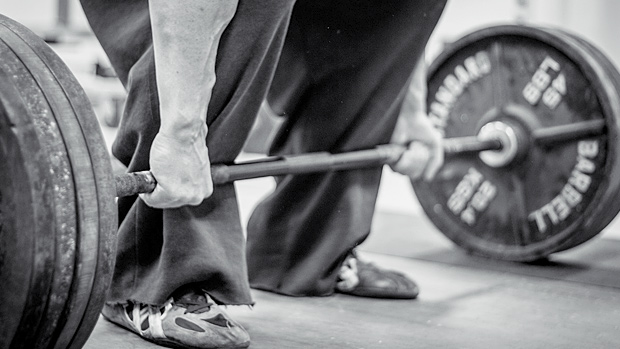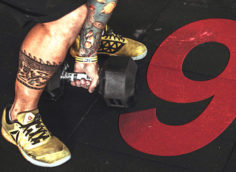When JL first started powerlifting, he sucked at the deadlift, so he sought out the best. Chuck Vogelpohl became his training partner and his understanding of the deadlift changed forever.
Sprinkle in a lot of coaching time with Louis Simmons, Dave Tate, Steve Goggins, and Eddie Coan, and JL turned into a professor of the deadlift. His best pull in a meet is 804 pounds and you don't pull over 800 pounds without picking up a few tricks of the trade.
As an expert, he's become keenly aware of the single most important and under-coached aspect of the deadlift, which is how you set the bar down when doing reps or, as he likes to refer to it, the dead-lower.
It's the thing that almost all lifters are f*cking up and the reason their pull is stuck. So set yourself up for success by mastering the fundamental concepts that have been hiding from you in plain sight. Once you master the initial setup and the basic mechanics of the lift, you'll quickly see that the greatest opportunity to improve comes from putting the bar down better.
If you're not methodical about the way you put the bar back down, you're messing with your next rep. At best, you're being inefficient. At worst, you're putting unnecessary stresses on your joints and practicing sloppy mechanics. And that's just not how people get strong and then stay strong.
Here's a list of the most common technical errors you'll see when it comes to lowering the bar, or the steps that immediately precede it.
When you've reached lockout, do you stop moving, or do you continue to extend through the spine? If you keep moving, be aware you get no extra credit for doing a back bend at the top of your deadlift. Just f*cking stop when the hips reach extension.
The deadlift is a simple movement. Your hips move, your knees move, and even your ankles move. But nobody said anything about your lumbar spine. The truth is, many people fake hip extension by cranking on their lower back.
Think of it this way: If your hips have stopped moving but you're still driving forward, that's how you know it's your back moving. This nasty habit releases both lat and anterior core tension so that the big muscles that keep you safe are now relaxed.
This increases your risks without any further improvement in performance. It's not a great trade-off, especially since it'll compromise your next dead-lower before it's even started. Think of this as setting up the setup for your setup.
Quad-dominant people love to do this, but shooting your knees forward is a sign of a weak posterior chain and it's a good way to hurt your back.
If you're intent on moving anything truly heavy, you need to keep it as close to your center of mass as possible. Shooting the knees forward and sliding the bar down the quads like they're a ramp will launch you into shitty deadlift land.
That makes things less efficient and compromises your ability to move some real weight around. What you want to do is hinge back and once the bar has cleared the knees, you squat down. The video contrasts "ramping the bar" with good form:
Telling people to squat at the bottom has helped us teach thousands of people to dead-lower correctly. A deadlift is nothing more than a Romanian deadlift (RDL) until the bar passes the knees, at which point you squat. As with any squat, the knees and butt must move down. People confuse this and forget the squat part, which causes major issues.
Look at it this way: Assuming you're not a contortionist, forgetting to squat down will exhaust your range of motion at the hips before the bar has touched down. With no more hip flexion to give, further movement has to come from somewhere. And if your hips and knees aren't moving BUT the bar is still travelling down, that's your spine doing the work, homie!
You can't lift massive loads safely if the movement comes from the sacroiliac (SI) or lumbar spine instead of the hips. You'll also have to readjust everything to be in good position to pull your next rep off the floor; either that or crush your back picking it up in the same way you just set it down in.
That's more work, or more wear and tear, to get the same job done.
You're 40% stronger eccentrically than concentrically. This means if you're not strong enough to lower the bar correctly, you shouldn't be picking that weight up anyway.
Now, if you're in a meet or going for a max attempt, we're cool with you letting all the tension out and doing a controlled drop before you celebrate a massive PR. This will happen at most four times per year.
Generally speaking, though, don't be a douchebag and drop the bar from the top. We don't care if you have bumpers on the bar (which just means you aren't very strong because you can't go over 500 with bumpers), but don't ever, ever, let go of the bar and drop it from the top.
This wouldn't count in a meet, it deprives you of 50% of the benefit of the lift, and at Westside, this would get you punched in the face.
Don't get us wrong, a 500-pound deadlift is pretty respectable. However, you should still be able to put the bar down without scaring the grandad in the back of the gym as he tries to do his rotator cuff rehab exercises in peace.
Solid control and tension is warranted 99% of the time for just about everyone, but all that being said, you don't have to act like you're putting the bar down on top of a bunch of robin's eggs. A good rule of thumb is that it shouldn't take you any more than two times as long to set it down as it took you to pick it up.
If you lift at a place where you can't make any noise at all while setting the bar down, well, f*ck those people. It's called a training facility, not a library. The clanging of plates is a beautiful zen sound that only the devil himself would want to eliminate.
A good hinge followed by a controlled drop from about the mid-shins is just fine, though. The goal with any controlled drop is for the bar to have a vertical path. If you begin dropping it too early, it will – once again – roll away with you and mess with your mechanics.
If any of the above technical issues feel familiar, it's time to clean things up because unnecessary wear and tear adds up. And while serious deadlifting doesn't exactly feel like a backrub and a homecooked meal, the best way to extend your lifting lifespan is to keep your physical stresses channelled into places that will strengthen you instead of beating you up.
The only way to make this happen in the deadlift is to master the dead-lower.




